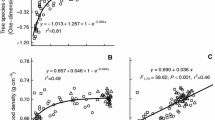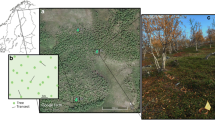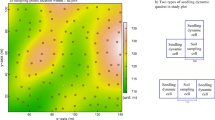Abstract
Buttress trees are prominent in tropical rainforests, providing mechanical support for canopy trees. Other ecological functions of these structures remain unclear. Here we demonstrate that buttresses are physical structures that regulate soil moisture, soil nutrient status and seedling diversity near tree trunks. We monitored soil moisture over a year in plots on the uphill, downhill and lateral sides of buttresses on a tropical seasonal rainforest slope in Xishuangbanna, Southwest China. Soil nutrient status was examined in dry and rainy season and seedlings were identified and counted in the plots. Leaf litter accumulation was sampled at the end of the study. Higher levels of soil moisture were maintained uphill of the buttresses throughout the year and leaf litter accumulation was also much higher. Total soil carbon, total N, and hydrolysable N were much higher on the uphill side but other nutrient concentrations did not differ significantly. Seedling species composition varied significantly among different locations with the densest and most diverse seedling assemblages on the uphill side. This study illustrates an important function of buttress trees in providing soil heterogeneity and promoting seedling diversity in rainforests.



Similar content being viewed by others

References
Black HL, Harper KT (1979) The adaptive value of buttresses to tropical trees: additional hypotheses. Biotropica 11:240–240
Bungard R, Scholes J, Press M (2000) The influence of nitrogen on rain forest dipterocarp seedlings exposed to a large increase in irradiance. Plant Cell Environ 23:1183–1194
Cao M, Zhang JH, Feng ZL, Deng JW, Deng XB (1996) Tree species composition of a seasonal rain forest in Xishuangbanna, southwest China. Trop Ecol 37:183–192
Cao M, Zou X, Warren M, Zhu H (2006) Tropical forests of Xishuangbanna, China. Biotropica 38:306–309
Chazdon RL (1984) Light environments of tropical forests. In: Medina E, Mooney HA, Vazquez-Yanes C (eds) Physiological ecology of plants of the wet tropics. Dr. J. Junk Publishers, The Netherlands
Clarke KR, Green RH (1988) Statistical design and analysis for a “biological effects” study. Mar Ecol Prog Ser 46:213–226
Clarke KR, Warwick RM (2001) Primer 5. PRIMER-E Ltd, University of Plymouth, Plymouth
Colwell RK (2009). EstimateS: Statistical estimation of species richness and shared species from samples. Version 8.2. Department of Ecology & Evolutionary Biology, University of Connecticut Storrs, USA
Ennos AR (1993) The function and formation of buttresses. Trends Ecol Evol 8:350–350
Garwood NC (1989) Tropical soil seed banks: a review. In: Leck MA, Parker VT, Simpson RL (eds) Ecology of soil seed banks. Academic, San Diego, pp 149–209
Grubb PJ (1977) The maintenance of species-richness in plant communities: the importance of the regeneration niche. Biol Rev 52:107–145
Herwitz SR (1988) Buttresses of tropical rainforest trees influence hillslope processes. Earth Surf Process Landf 13:563–567
John R, Dalling JW, Harms KE, Yavitt JB, Stallard RF, Mirabello M, Hubbell SP, Valenciar R, Navarrete H, Vallejo M (2007) Soil nutrients influence spatial distributions of tropical tree species. PNAS 104:864–869
Johnson MS, Lehmann J (2006) Double-funneling of trees: stemflow and root-induced preferential flow. Ecoscience 13:324–333
Legendre P, Legendre L (1998) Numerical ecology, 2nd edn. Elsevier, Amsterdam
Metcalfe DJ, Grubb PJ, Turner IM (1998) The ecology of very small-seeded shade-tolerant trees and shrubs in lowland rain forest in Singapore. Plant Ecol 134:131–149
Newbery DM, Schwan S, Chuyong GB, van der Burgt XM (2009) Buttress form of the central African rain forest tree Microberlinia bisulcata, and its possible role in nutrient acquisition. Trees-Struct Func 23:219–234
Pammenter N, Berjak P (2000) Some thoughts on the evolution and ecology of recalcitrant seeds. Plant Species Biol 15:153–156
Poorter L, Hayashida-Oliver Y (2000) Effects of seasonal drought on gap and understorey seedlings in a Bolivian moist forest. J Trop Ecol 16:481–498
Poorter L, Markesteijn L (2008) Seedling traits determine drought tolerance of tropical tree species. Biotropica 40:321–331
Putz F (1984) The natural history of lianas on Barro Colorado Island, Panama. Ecology 65:1713–1724
Quinn GP, Keough MJ (2002) Experimental design and data analysis for biologists. Cambridge University Press, Cambridge
Richards PW (1996) The tropical rain forest. Cambridge University Press, Cambridge
Richter W (1984) A structural approach to the function of buttresses of Quararibea asterolepis. Ecology 65:1429–1435
Senn G (1923) Uber die Uraschen der Brettwurzelbildung bei der Pyramiden-Pappel. Verh. Nat. Ges. Basel 35:405–435
Smith AP (1972) Buttressing of tropical trees: a descriptive model and new hypotheses. Am Nat 106:32–46
Swift MJ, Heal OW, Anderson JM (1979) Decomposition in terrestrial ecosystems. University of California Press, Berkeley
Tweddle JC, Dickie JB, Baskin CC, Baskin JM (2003) Ecological aspects of seed desiccation sensitivity. J Ecol 91:294–304
Vazquez-Yanes C, Orozco-Segovia A (1993) Patterns of seed longevity and germination in the tropical rainforest. Ann Rev Ecolog Syst 24:69–87
Voris HK (1977) Comparison of herpetofaunal diversity in tree buttresses of evergreen tropical forests. Herpetologica 33:375–380
Warren SD, Black HL, Eastmond DA, Whaley WH (1988) Structural function of buttresses of Tachigalia versicolor. Ecology 69:532–536
Whitfield SM, Pierce MSF (2005) Tree buttress microhabitat use by a Neotropical leaf-litter herpetofauna. J Herpetol 39:192–198
Whitmore TC (1998) An introduction to tropical rain forest. Oxford University Press, New York
Wright SJ (2002) Plant diversity in tropical forests: a review of mechanisms of species coexistence. Oecologia 130:1–14
Yavitt JB, Wright JS (2008) Seedling growth responses to water and nutrient augmentation in the understorey of a lowland moist forest, Panama. J Trop Ecol 24:19–26
Young TP, Hubbell SP (1991) Crown asymmetry, treefalls, and repeat disturbance of broad-leaved forest gaps. Ecology 72:1464–1471
Young TP, Perkocha V (1994) Treefalls, crown asymmetry, and buttresses. J Ecol 82:319–324
Acknowledgements
We thank the Xishuangbanna Station for Tropical Rainforest Ecosystem Studies, the Chinese Academy of Science for providing research facilities and rainfall data; Pierre Legendre for his help with data analysis and John Kanowski, Douglas Schaefer and two anonymous reviewers for their valuable comments on the manuscript. This work was supported by a Knowledge Innovation Program of the Chinese Academy of Science (KZCX2-YW-430), a grant from National Natural Science Foundation of China (31070411) and a National Science & Technology Pillar Program from the Ministry of Environmental Protection of P.R. China (2008BAC39B02).
Author information
Authors and Affiliations
Corresponding author
Additional information
Responsible Editor: Rafael S. Oliveira.
Rights and permissions
About this article
Cite this article
Tang, Y., Yang, X., Cao, M. et al. Buttress trees elevate soil heterogeneity and regulate seedling diversity in a tropical rainforest. Plant Soil 338, 301–309 (2011). https://doi.org/10.1007/s11104-010-0546-4
Received:
Accepted:
Published:
Issue Date:
DOI: https://doi.org/10.1007/s11104-010-0546-4



